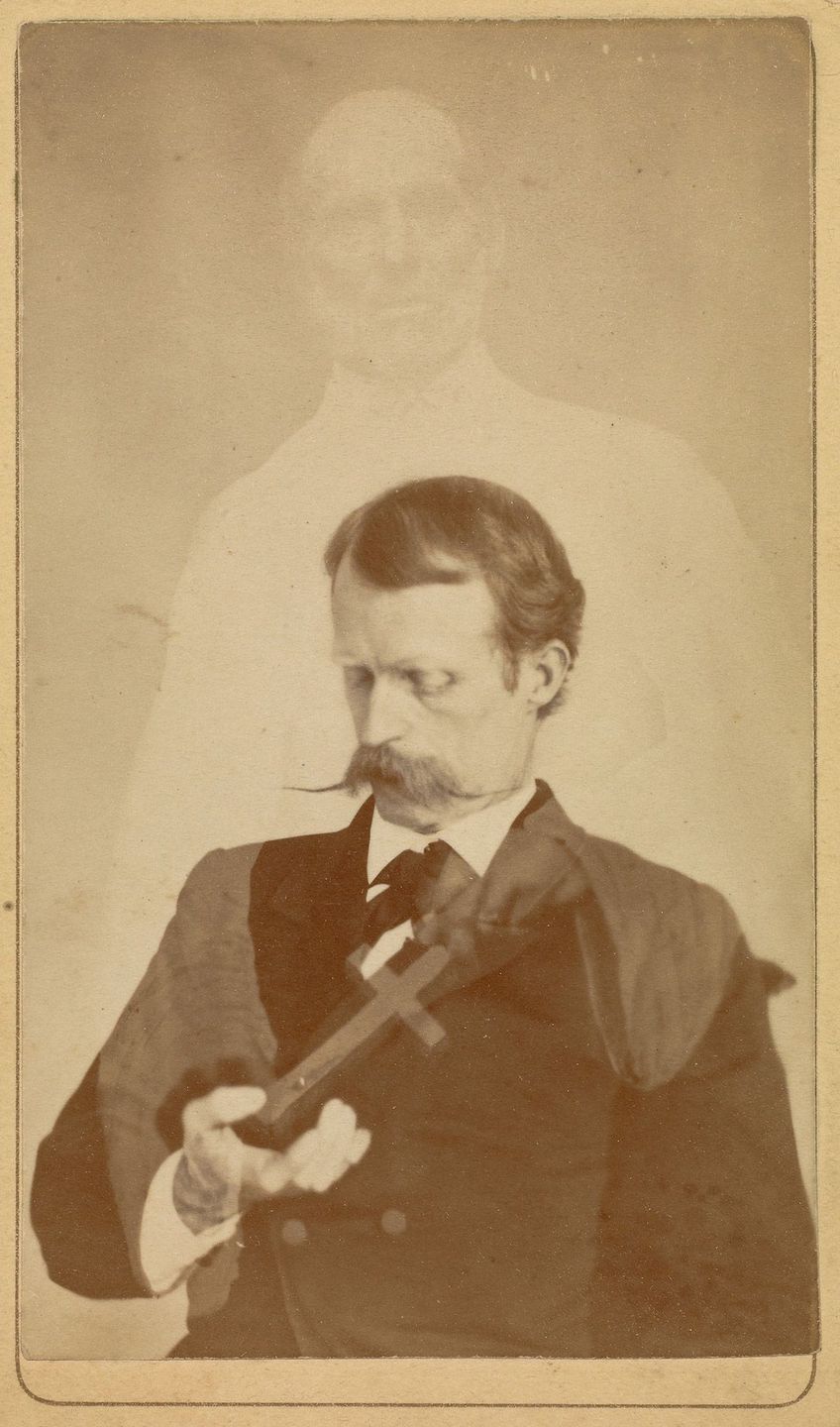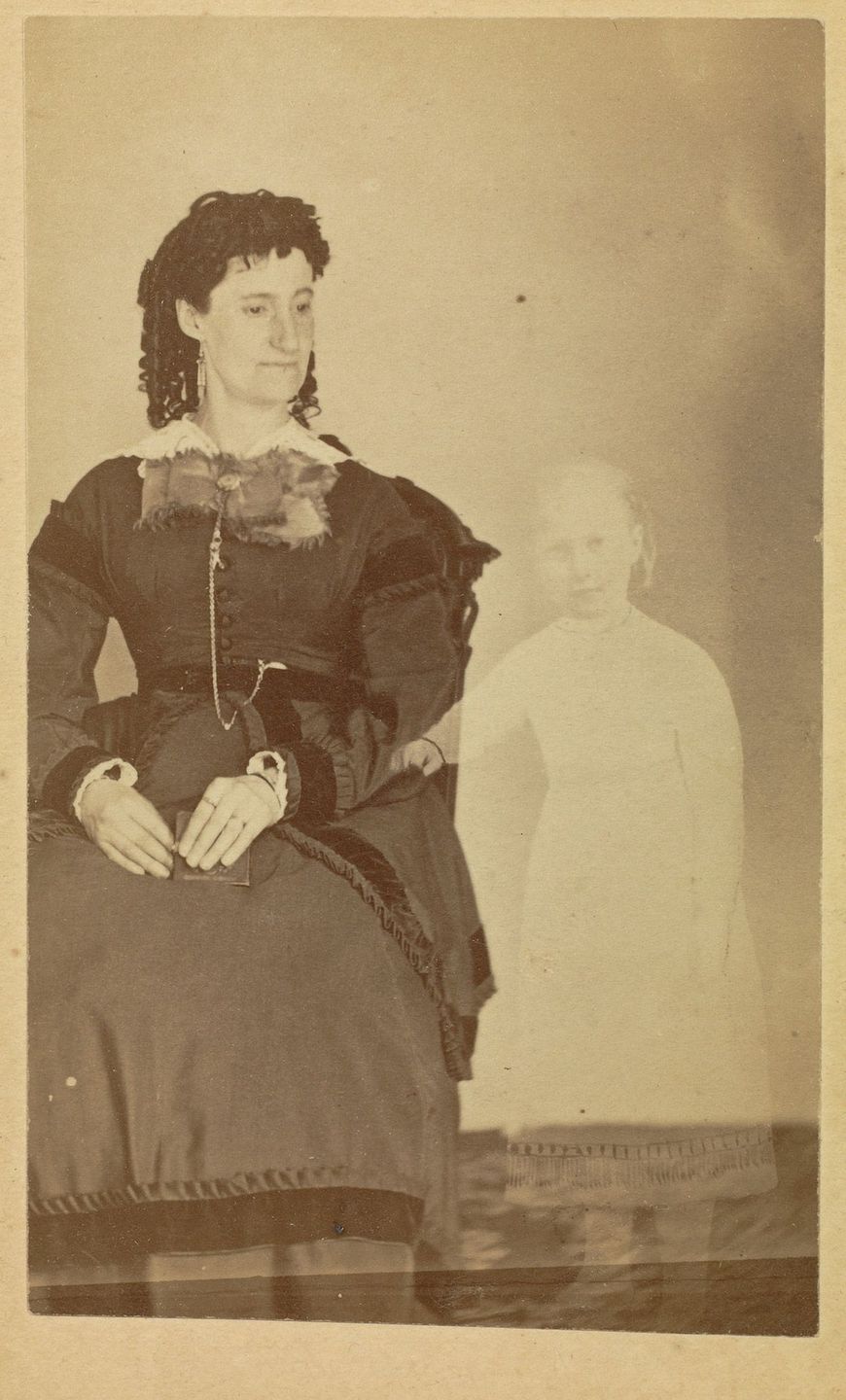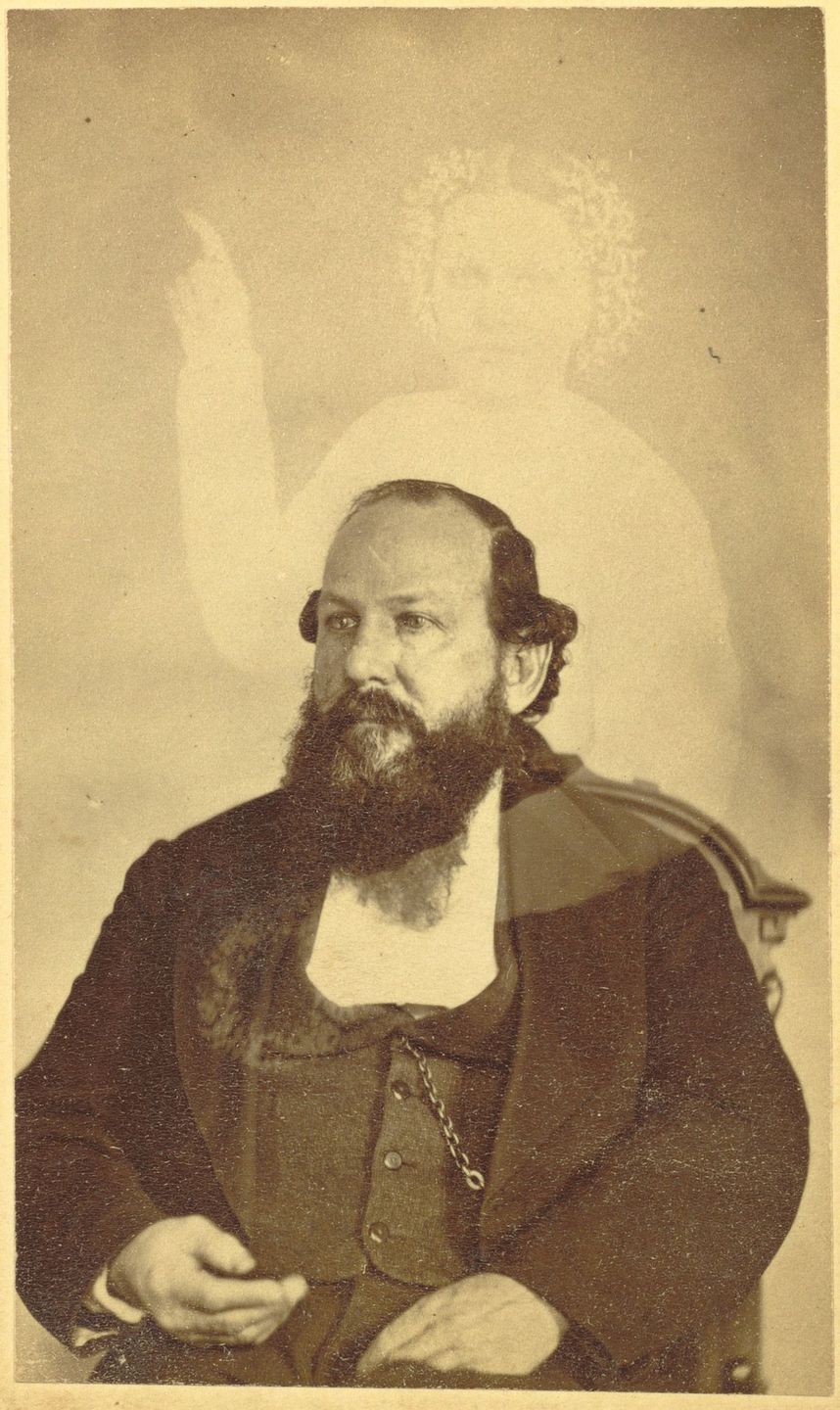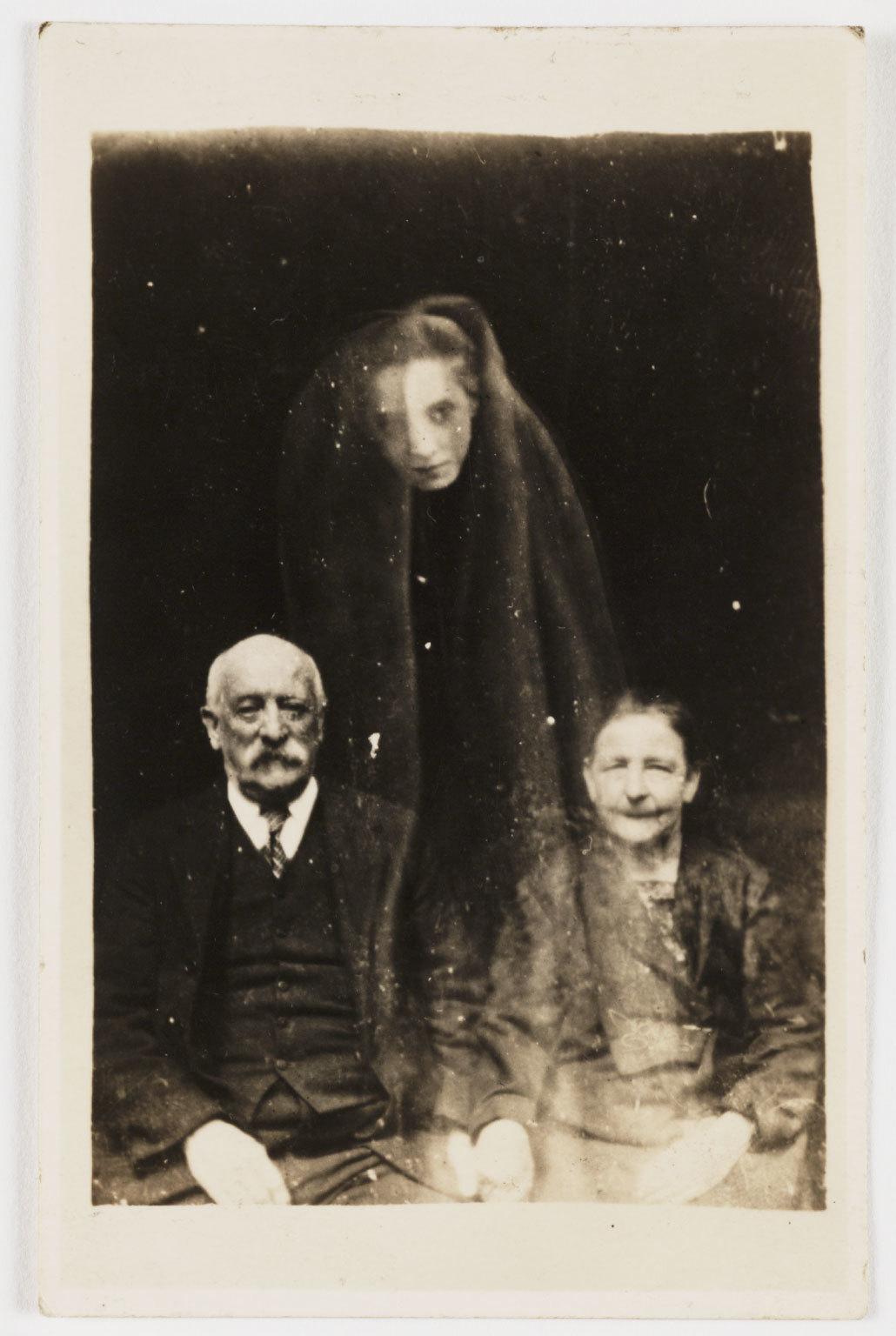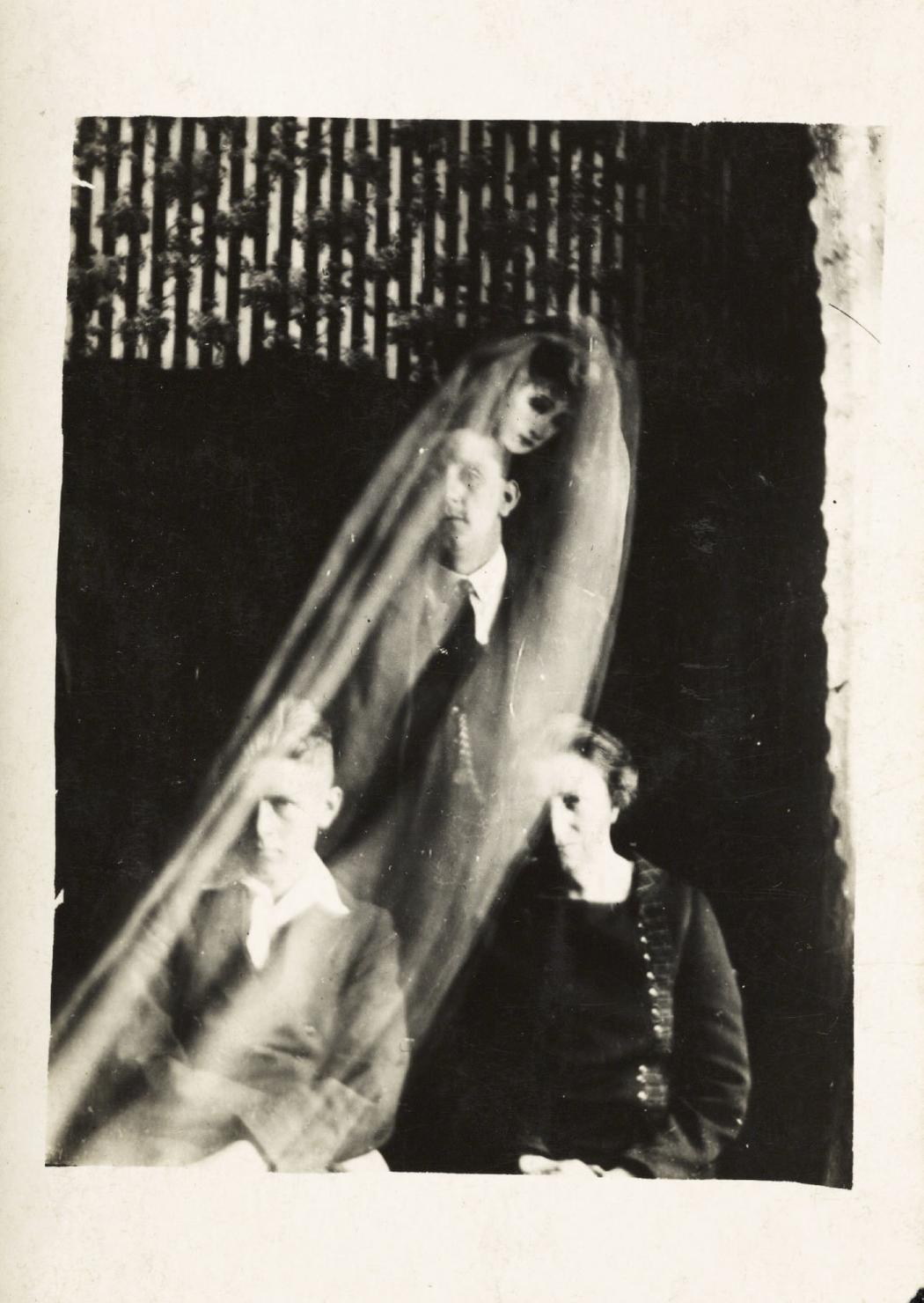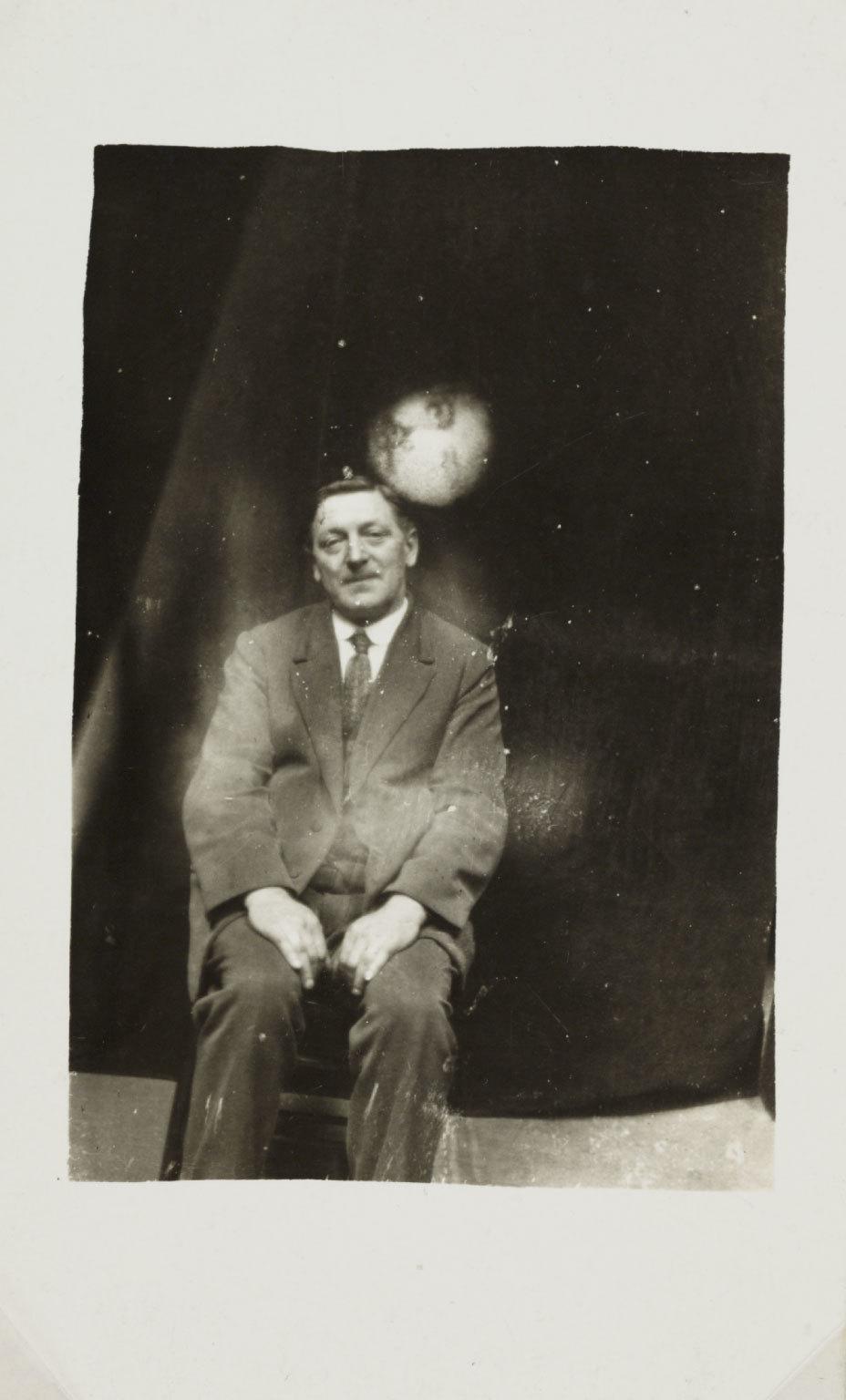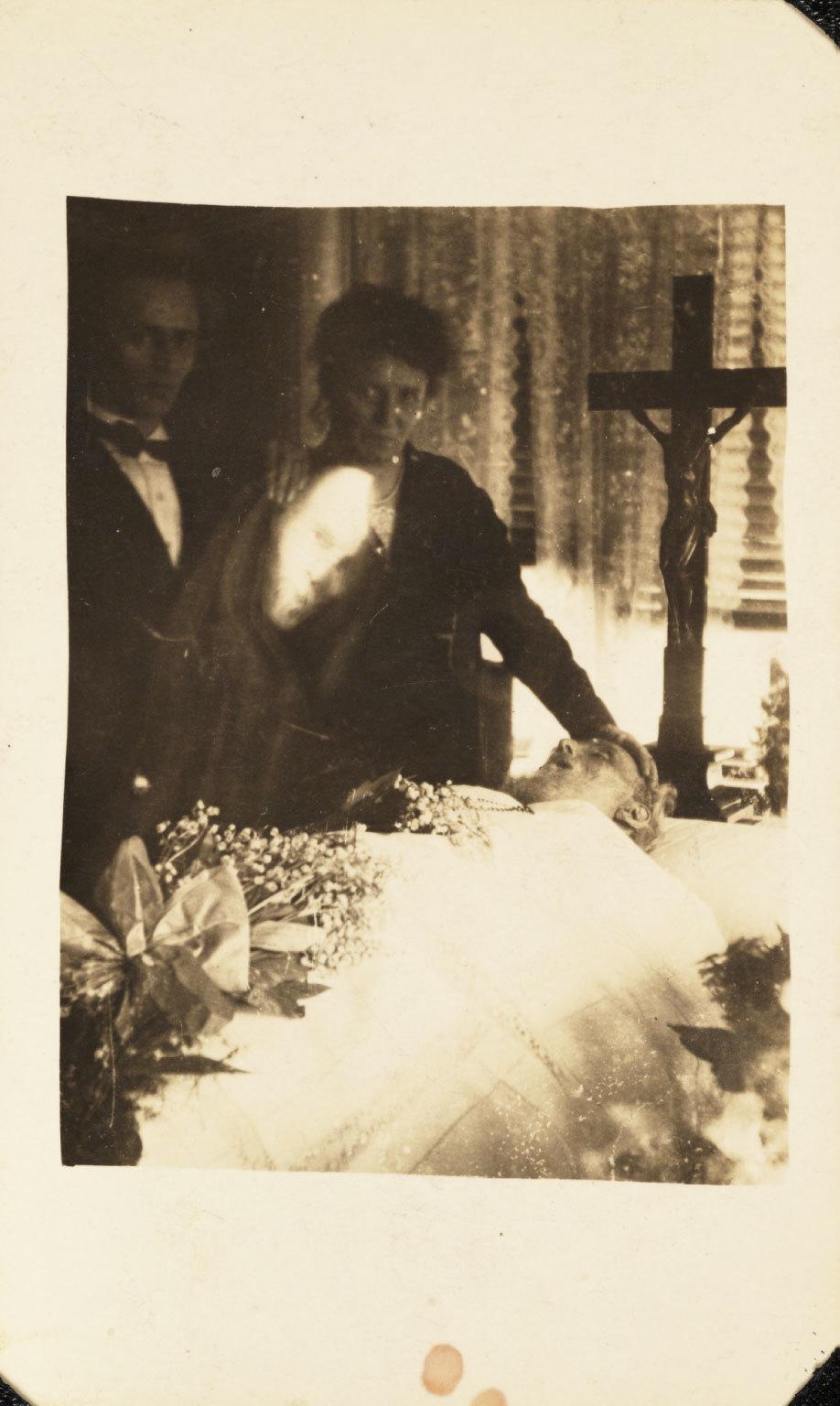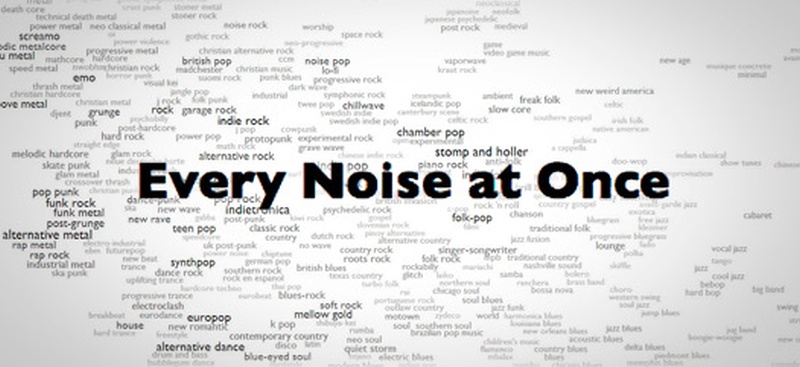[Most Recent Entries] [Calendar View]
Friday, October 13th, 2017
| Time | Event |
| 8:00a | Eerie 19th Century Photographs of Ghosts: See Images from the Long, Strange Tradition of “Spirit Photography”
We might draw any number of conclusions from the fact that rats’ brains are enough like ours that they stand in for humans in laboratories. A misanthropic existentialist may see the unflattering similarity as evidence that there’s nothing special about human beings, despite our grandiose sense of ourselves. A medieval European thinker would draw a moral lesson, pointing to the rat’s gluttony as nature’s allegory for human greed. And a skeptical observer in the 19th and early 20th centuries might take note of how easily both rats and humans can be manipulated; the latter, for example, by pseudo-phenomena like Spiritualism, which encompassed a wide range of claims about ghosts and the afterlife, from seances to spirit photography.
One such skeptical observer in 1920, Millaias Culpin, even wrote in his Spiritualism and the New Psychology of the “’scientific’ supporters of spiritualism,” most of them “eminent in physical science.” They are easily convinced, Culpin thought, because “they have been trained in a world where honesty is assumed to be a quality of all workers. A laboratory assistant who played a trick upon one of them would find his career at an end, and ordinary cunning is foreign to them. When they enter upon the world of Dissociates, where deceit masquerades under the disguise of transparent honesty, these eminent men are but as babes—country cousins in the hands of confidence-trick men.”
Such adherents of Spiritualist beliefs were taken in not because they were naturally credulous or stupid, but because they had been “trained” to trust the evidence of their senses. So-called spirit photographs, like those you see here, allowed people to “show material evidence for their beliefs.” Photographers who created the images, Mashable explains, could "easily make two exposures on a single negative, manipulate the negative to create ghostly blurs, or overlap two negatives in the darkroom to produce an extra face within the resultant frame." The audience for this work was "vast," and many fit Culpin's generalizations. In 1921, for example, paranormal investigator Hereward Carrington wrote of “a number of ‘spirit’ and ‘thought’ photographs, the evidence for which seemed to me to be exceptionally good.” In describing other pictures as “obviously fraudulent” or “extremely puzzling,” Carrington made critical distinctions and appeared to use the methods and the language of science in the evaluation of objects purporting to prove the existence of ghosts.
It may seem incredible that spirit photography had widespread appeal for as long as it did. The photographs first began appearing in the 1860s, emerging “from a small Boston portrait studio” and first made by William H. Mumler, the genre’s inventor and “most prominent early proponent,” writes Mashable.
These ghostly images continued to appear—on their own, the story goes—and the studio’s receptionist, a part-time medium, helped popularize them. Soon Mumler “received visitors from across America, including the recently widowed Mary Todd Lincoln.” Most of these visitors did not work as scientists or professional paranormal investigators. They were ordinary people bereaved by the mass death of the Civil War and deeply motivated to accept physical confirmation of an afterlife. Moreover, before the rise of Fundamentalist Evangelicalism in the 1920s, Spiritualism was on the front lines of an earlier culture war: spirit photography was “a tangible symbol of the overarching argument of mysticism versus science and rationalism.”
The three images at the top of the post date from the earliest period of spirit photography, between 1862 and 1875, and they were all produced by Mumler in Boston and New York, where he moved in 1869, and where he was charged with fraud, then “acquitted of all charges because they could not be sufficiently proven.” (See many more of his photos at Mashable and the Getty Museum online archive.) Though his business suffered, spirit photography only grew more popular, particularly in Spiritualist circles in Britain, where Arthur Conan Doyle, creator of the hyper-rational Sherlock Holmes, was one of the most ardent of Spiritualist believers.
Doyle supported a British photographer named William Hope, who began taking spirit photographs in 1905, founded a group called the Crewe Circle and later “went on to prey on grieving families,” writes River Donaghey at Vice, “who lost loved ones in WWI and desperately wanted photographic proof that their relatives were still hovering around in spectral form.” Even after Hope and his crew were exposed, Doyle continued to support him, going so far as to write a book called The Case for Spirit Photography. The four photographs above and below are Hope’s work (see many more at Vice and the Public Domain Review). They are seriously creepy—in the way movies like The Ring are creepy—but they are also, quite obviously, photographic fictions.
Even as viewers of photography became savvier as the century wore on, many people thrilled to Hope’s work until his death in 1933, maybe for the same reason we watch The Ring; it’s a fun scare, nothing more, if we suspend our disbelief. As for the true believers in spirit photography—they are not so different either from us 21st century sophisticates. We’re still taken in all the time by hoaxes and frauds, maybe because it’s still as easy to push the buttons in our brains, and because, well, we just want to believe. Related Content: Arthur Conan Doyle & The Cottingley Fairies: How Two Young Girls Fooled Sherlock Holmes’ Creator Browse The Magical Worlds of Harry Houdini’s Scrapbooks Josh Jones is a writer and musician based in Durham, NC. Follow him at @jdmagness Eerie 19th Century Photographs of Ghosts: See Images from the Long, Strange Tradition of “Spirit Photography” is a post from: Open Culture. Follow us on Facebook, Twitter, and Google Plus, or get our Daily Email. And don't miss our big collections of Free Online Courses, Free Online Movies, Free eBooks, Free Audio Books, Free Foreign Language Lessons, and MOOCs. |
| 2:00p | Hear 1,500+ Genres of Music, All Mapped Out on an Insanely Thorough Interactive Graph
If you are ready for a time-suck internet experience that will also make you feel slightly old and out of step with the culture, feel free to dive into Every Noise at Once. A scatter-plot of over 1,530 musical genres sourced from Spotify’s lists and based on 35 million songs, Every Noise at Once is a bold attempt at musical taxonomy. The Every Noise at Once website was created by Glenn McDonald, and is an offshoot of his work at Echo Nest (acquired by Spotify in 2014). McDonald explains his graph thus:
It’s also egalitarian, with world dominating “rock-and-roll” given the same space and size as its neighbors choro (instrumental Brazilian popular music), cowboy-western (Conway Twitty, Merle Haggard, et. al.), and Indian folk (Asha Bhosle, for example). It also makes for some strange bedfellows: what factor does musique concrete share with “Christian relaxitive” other than “reasons my college roommate and I never got along.” Now you can find out! Click on any of the genres and you’ll hear a sample of that music. Double click and you’ll be taken to a similar scatter-plot graph of its most popular artists, this time with font size denoting popularity and a similar sample of their music. I’ve been spending most of my time exploring up in the top right corner where all sorts of electronic dance subgenres hang out. I’m not too sure what differentiates “deep tech house” from “deep deep house” or “deep minimal techno” or “tech house” or even “deep melodic euro house” but I now know where to come for a refresher course. [Error: Irreparable invalid markup ('<div [...] http://cdn8.openculture.com/>') in entry. Owner must fix manually. Raw contents below.] <p><img class="alignleft size-full wp-image-1043455" src="http://cdn8.openculture.com/2017/10/12174625/every-noise-at-once-2.jpg" alt="" srcset="http://cdn8.openculture.com/2017/10/12174625/every-noise-at-once-2.jpg 800w, http://cdn8.openculture.com/2017/10/12174625/every-noise-at-once-2-150x69.jpg 150w, http://cdn8.openculture.com/2017/10/12174625/every-noise-at-once-2-300x138.jpg 300w, http://cdn8.openculture.com/2017/10/12174625/every-noise-at-once-2-768x352.jpg 768w" sizes="(max-width: 800px) 100vw, 800px" width="320"/></p>
<p>If you are ready for a time-suck internet experience that will also make you feel slightly old and out of step with the culture, feel free to dive into<a href="http://everynoise.com/engenremap.html"> Every Noise at Once</a>. A scatter-plot of over 1,530 musical genres sourced from Spotify’s lists and based on 35 million songs, <a href="http://everynoise.com/engenremap.html"> Every Noise at Once</a> is a bold attempt at musical taxonomy. The<a href="http://everynoise.com/engenremap.html"> Every Noise at Once</a> <a href="http://everynoise.com/engenremap.html">website</a> was created by Glenn McDonald, and is an offshoot of his work at Echo Nest (acquired by Spotify in 2014).</p>
<p>McDonald explains his graph thus:</p>
<blockquote><p>This is an ongoing attempt at an algorithmically-generated, readability-adjusted scatter-plot of the musical genre-space, based on data tracked and analyzed for 1,536 genres by Spotify. The calibration is fuzzy, but in general down is more organic, up is more mechanical and electric; left is denser and more atmospheric, right is spikier and bouncier.</p></blockquote>
<p>It’s also egalitarian, with world dominating “rock-and-roll” given the same space and size as its neighbors choro (instrumental Brazilian popular music), cowboy-western (Conway Twitty, Merle Haggard, et. al.), and Indian folk (Asha Bhosle, for example). It also makes for some strange bedfellows: what factor does musique concrete share with “Christian relaxitive” other than “reasons my college roommate and I never got along.” Now you can find out!</p>
<div class="oc-center white_background noexpand">
</div>
<p>Click on any of the genres and you’ll hear a sample of that music. Double click and you’ll be taken to a similar scatter-plot graph of its most popular artists, this time with font size denoting popularity and a similar sample of their music.</p>
<p>I’ve been spending most of my time exploring up in the top right corner where all sorts of electronic dance subgenres hang out. I’m not too sure what differentiates “deep tech house” from “deep deep house” or “deep minimal techno” or “tech house” or even “deep melodic euro house” but I now know where to come for a refresher course.</p>
<div class="oc-center"http://cdn8.openculture.com/>
<p>Spotify and other services depend on algorithms and taxonomies like this to deliver consistent listening experiences to its users, and they were attracted to Echo Nest for its work with genres. Echo Nest was originally based on the dissertation work of <a href="http://web.media.mit.edu/~tristan/">Tristan Jehan</a> and <a href="http://alumni.media.mit.edu/~bwhitman/">Brian Whitman</a> at the <a href="https://www.media.mit.edu/">MIT Media Lab</a>, who over a decade ago were trying to understand the “fingerprints” of recorded music. Now when you listen to Spotify’s personalized playlists, Echo Nest’s research is the engine working in the background.</p>
<p>McDonald says in <a href="https://www.dailydot.com/debug/every-noise-at-once-echo-nest/">this 2014</a> <em><a href="https://www.dailydot.com/debug/every-noise-at-once-echo-nest/">Daily Dot</a></em> article this isn’t about a machine guessing our taste.</p>
<p>“No, the machines don’t know us better than we do. But they can very easily know more than we do. My job is not to tell you what to listen to, or to pass judgment on things or ‘make taste.’ It’s to help you explore and discover. Your taste is your business. Understanding your taste and situating it in some intelligible context is my business.”</p>
<p>If you’d like a more passive journey through the ever expanding music genre universe, there's a <a href="https://open.spotify.com/user/thesoundsofspotify/playlist/69fEt9DN5r4JQATi52sRtq">Spotify playlist</a> of one song from each genre (all 1,500+) above. See you in the deep, deep house!</p>
<p>via <a href="https://kottke.org/17/10/audio-samples-of-1500-musical-genres">Kottke.org</a></p>
<p><strong>Related Content:</strong></p>
<p><a href="http://www.openculture.com/2017/10/the-history-of-hip-hop-music-visualized-on-a-turntable-circuit-diagram.html">The History of Hip Hop Music Visualized on a Turntable Circuit Diagram: Features 700 Artists, from DJ Kool Herc to Kanye West</a></p>
<p><a href="http://www.openculture.com/2014/02/crime-jazz.html">Crime Jazz: How Miles Davis, Count Basie & Duke Ellington Created Soundtracks for Noir Films & TV</a></p>
<p><a href="http://www.openculture.com/2016/01/stockhausen-lectures-on-electronic-music-in-1972.html">Pioneering Electronic Composer Karlheinz Stockhausen Presents “Four Criteria of Electronic Music” & Other Lectures in English (1972)</a></p>
<p><em> Ted Mills is a freelance writer on the arts who currently hosts the <a href="http://www.funkzonepodcast.com/">FunkZone Podcast</a>. You can also follow him on Twitter at <a href="http://www.twitter.com/tedmills">@tedmills</a>, read his other arts writing at <a href="http://www.tedmills.com">tedmills.com</a> and/or watch his films <a href="https://vimeo.com/user749601">here</a>.</em></p>
<!-- permalink:http://www.openculture.com/2017/10/1500-music-genres-mapped-out-on-an-insanely-thorough-interactive-graph.html--><p><a rel="nofollow" href="http://www.openculture.com/2017/10/1500-music-genres-mapped-out-on-an-insanely-thorough-interactive-graph.html">Hear 1,500+ Genres of Music, All Mapped Out on an Insanely Thorough Interactive Graph</a> is a post from: <a href="http://www.openculture.com">Open Culture</a>. Follow us on <a href="https://www.facebook.com/openculture">Facebook</a>, <a href="https://twitter.com/#!/openculture">Twitter</a>, and <a href="https://plus.google.com/108579751001953501160/posts">Google Plus</a>, or get our <a href="http://www.openculture.com/dailyemail">Daily Email</a>. And don't miss our big collections of <a href="http://www.openculture.com/freeonlinecourses">Free Online Courses</a>, <a href="http://www.openculture.com/freemoviesonline">Free Online Movies</a>, <a href="http://www.openculture.com/free_ebooks">Free eBooks</a>, <a href="http://www.openculture.com/freeaudiobooks">Free Audio Books</a>, <a href="http://www.openculture.com/freelanguagelessons">Free Foreign Language Lessons</a>, and <a href="http://www.openculture.com/free_certificate_courses">MOOCs</a>.</p>
<div class="feedflare">
<a href="http://feeds.feedburner.com/~ff/OpenCulture?a=VYdkRv66HfE:ZVL6_iL4yf8:yIl2AUoC8zA"><img src="http://feeds.feedburner.com/~ff/OpenCulture?d=yIl2AUoC8zA" border="0"></img></a> <a href="http://feeds.feedburner.com/~ff/OpenCulture?a=VYdkRv66HfE:ZVL6_iL4yf8:V_sGLiPBpWU"><img src="http://feeds.feedburner.com/~ff/OpenCulture?i=VYdkRv66HfE:ZVL6_iL4yf8:V_sGLiPBpWU" border="0"></img></a> <a href="http://feeds.feedburner.com/~ff/OpenCulture?a=VYdkRv66HfE:ZVL6_iL4yf8:gIN9vFwOqvQ"><img src="http://feeds.feedburner.com/~ff/OpenCulture?i=VYdkRv66HfE:ZVL6_iL4yf8:gIN9vFwOqvQ" border="0"></img></a> <a href="http://feeds.feedburner.com/~ff/OpenCulture?a=VYdkRv66HfE:ZVL6_iL4yf8:qj6IDK7rITs"><img src="http://feeds.feedburner.com/~ff/OpenCulture?d=qj6IDK7rITs" border="0"></img></a> <a href="http://feeds.feedburner.com/~ff/OpenCulture?a=VYdkRv66HfE:ZVL6_iL4yf8:I9og5sOYxJI"><img src="http://feeds.feedburner.com/~ff/OpenCulture?d=I9og5sOYxJI" border="0"></img></a>
</div><img src="http://feeds.feedburner.com/~r/OpenCulture/~4/VYdkRv66HfE" height="1" width="1" alt=""/> |
| 4:30p | 20,000 Americans Hold a Pro-Nazi Rally in Madison Square Garden in 1939: Chilling Video Re-Captures a Lost Chapter in US History
Our country’s bipartisan system ensures that every election will give rise to a winning side and a losing side—and depressingly, a sizable group who refrained from casting a vote either way. There are times when the divide between the factions does not seem insurmountable, when leaders in the highest positions of authority seem sincerely committed to reaching across the divide…. And then there are other times. Earlier in the year, the Women’s March on Washington and its hundreds of sister marches gave many of us reason to hope. The numbers alone were inspiring. But history shows how great numbers can go the other way too. With many American high school history curriculums whizzing through World War II in a week, if that, it’s doubly important to slow down long enough to watch the 7 minute documentary above. What you’re looking at is the 1939 "Pro-American Rally" (aka Pro-Nazi Rally) sponsored by the German American Bund at Madison Square Garden on George Washington’s 207th Birthday. Banners emblazoned with such slogans as “Stop Jewish Domination of Christian Americans,” “Wake Up America. Smash Jewish Communism,” and “1,000,000 Bund Members by 1940" decorated the great hall. New York City Mayor Fiorello LaGuardia—an Episcopalian with a Jewish mother—considered canceling the event, but ultimately he, along with the American Jewish Committee and the American Civil Liberties Committee decreed that the Bund was exercising its right to free speech and free assembly. A crowd of 20,000 filled the famous sports venue in mid-town Manhattan to capacity. 1,500 police officers were present to render the Garden “a fortress impregnable to anti-Nazis.” An estimated 100,000 counter-demonstrators were gathering outside. Police Commissioner Lewis J. Valentine bragged to the press that “we have enough police here to stop a revolution.” The most disturbing moment in the short film comes at the 3:50 mark, when another security force—the Bund’s Ordnungsdienst or "Order Service” pile on Isidore Greenbaum, a 26-year-old Jewish worker who rushed the podium where bundesführer Fritz Julius Kuhn was fanning the flames of hatred. Valentine’s men eventually pulled them off, just barely managing to save the “anti-Nazi” from the vicious beating he was undergoing. Reportedly he was beaten again, as the crowd inside the Garden howled for his blood. The uniformed youth performing a spontaneous hornpipe in the row behind the Bund’s drum and bugle corps is a chilling sight to see. Director Marshall Curry was spurred to bring the historic footage to Field of Vision, a filmmaker-driven documentary unit that commissions short films as a rapid response to developing stories around the globe. In this case, the developing story was the “Unite the Right” white nationalist rally in Charlottesville, which had occurred a mere two days before. “The footage is so powerful,” Curry told an interviewer, “it seems amazing that it isn’t a stock part of every high school history class. But I think the rally has slipped out of our collective memory in part because it’s scary and embarrassing. It tells a story about our country that we’d prefer to forget. We’d like to think that when Nazism rose up, all Americans were instantly appalled. But while the vast majority of Americans were appalled by the Nazis, there was also a significant group of Americans who were sympathetic to their white supremacist, anti-Semitic message. When you see 20,000 Americans gathering in Madison Square Garden you can be sure that many times that were passively supportive.” Field of Vision co-founder Laura Poitras recalled how after meeting with Curry, “my first thought was, 'we need to put this film in cinemas,' and release it like a newsreel.”' The Alamo Drafthouse cinema chain screened it before features on September 26 of this year. The Atlantic has photos of the "Pro-American Rally" and other German American Bund-sponsored events in the days leading up to WWII here. Also read an account that appeared in a 1939 edition of The New York Times here. The International Socialist Review covers the counter-demonstrations in many eyewitness quotes. via PaleoFuture Related Content: Philosophers (Including Slavoj Žižek) and Ethicists Answer the Question: Is It OK to Punch Nazis? Ayun Halliday is an author, illustrator, theater maker and Chief Primatologist of the East Village Inky zine. Follow her @AyunHalliday. 20,000 Americans Hold a Pro-Nazi Rally in Madison Square Garden in 1939: Chilling Video Re-Captures a Lost Chapter in US History is a post from: Open Culture. Follow us on Facebook, Twitter, and Google Plus, or get our Daily Email. And don't miss our big collections of Free Online Courses, Free Online Movies, Free eBooks, Free Audio Books, Free Foreign Language Lessons, and MOOCs. |
| << Previous Day |
2017/10/13 [Calendar] |
Next Day >> |
